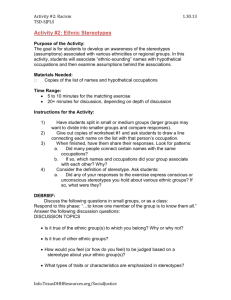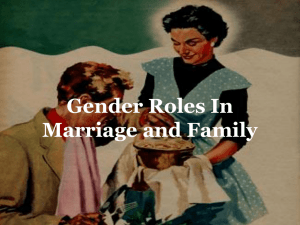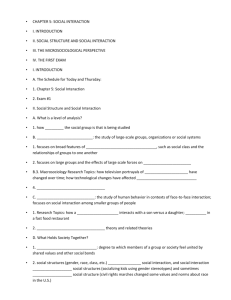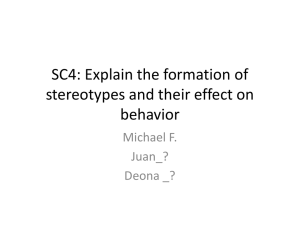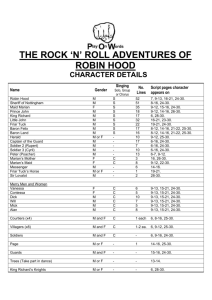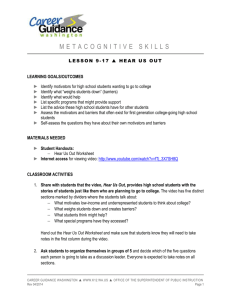Role Models from My Culture - Office of Superintendent of Public
advertisement
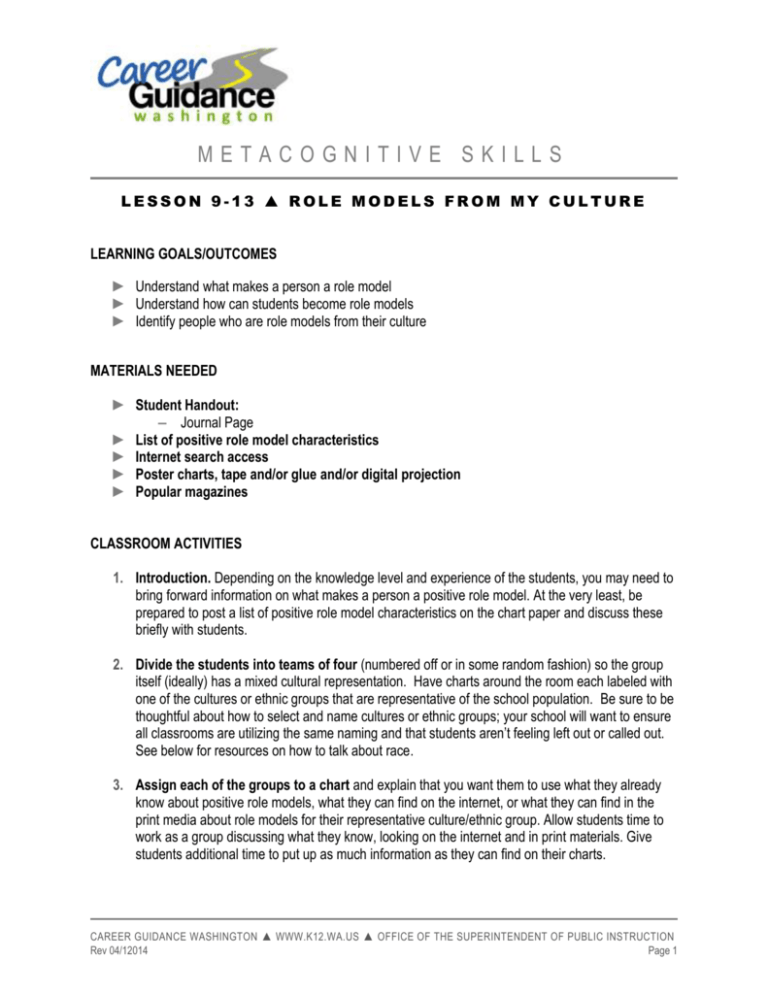
METACOGNITIVE SKILLS LESSON 9-13 ROLE MODELS FROM MY CULTURE LEARNING GOALS/OUTCOMES ► Understand what makes a person a role model ► Understand how can students become role models ► Identify people who are role models from their culture MATERIALS NEEDED ► Student Handout: – Journal Page ► List of positive role model characteristics ► Internet search access ► Poster charts, tape and/or glue and/or digital projection ► Popular magazines CLASSROOM ACTIVITIES 1. Introduction. Depending on the knowledge level and experience of the students, you may need to bring forward information on what makes a person a positive role model. At the very least, be prepared to post a list of positive role model characteristics on the chart paper and discuss these briefly with students. 2. Divide the students into teams of four (numbered off or in some random fashion) so the group itself (ideally) has a mixed cultural representation. Have charts around the room each labeled with one of the cultures or ethnic groups that are representative of the school population. Be sure to be thoughtful about how to select and name cultures or ethnic groups; your school will want to ensure all classrooms are utilizing the same naming and that students aren’t feeling left out or called out. See below for resources on how to talk about race. 3. Assign each of the groups to a chart and explain that you want them to use what they already know about positive role models, what they can find on the internet, or what they can find in the print media about role models for their representative culture/ethnic group. Allow students time to work as a group discussing what they know, looking on the internet and in print materials. Give students additional time to put up as much information as they can find on their charts. CAREER GUIDANCE WASHINGTON ▲ WWW.K12.WA.US ▲ OFFICE OF THE SUPERINTENDENT OF PUBLIC INSTRUCTION Rev 04/12014 Page 1 9-13 ▲ ROLE MODELS FROM MY CULTURE 4. Once the group has some role models (expect that some groups may have none), ask the group to discuss the following questions: – Were they surprised that it was easy or challenging to find role models in this ethnic group? Why do they think the task was easy or challenging? – What did they learn about the culture or ethnic group that they didn’t already know? How did information fit with their perception of stereotyping people by their race, culture or ethnicity? 5. Bring the whole group back together and discuss briefly what they learned. Ask students to consider what it is they “connect” with in the stories of the role models. 6. To conclude, ask each student to list role models from their culture in their journal page and write what it is about each person that makes them a role model. STUDENT PRODUCTS ► Completed Journal Page ADDITIONAL RESOURCES AND OTHER INFORMATION ► Supplemental Facilitator Notes This lesson is a continuation of a previous lesson, Lesson 8-13: “Role Models.” The intent of this lesson is to take students to a level deeper where they go back to consider people from their own culture who are role models and to think about how their story may or may not parallel the student’s story. Race, culture, ethnicity, like poverty, will play a continuing role in the advisory discussions. It will be important for advisors to help students create a safe community around these topics. Below are resources advisors might want to consider as support for these discussions. ► What Does Race Have to Do With It? http://www.whatsrace.org/pages/games.html This site provides teachers with a menu of activities that are rated: – Low risk – trust building activities and icebreakers – Medium risk – uncovering existing disparities – High risk – exploring one’s personal stake or vantage point ► Lesson Planet http://www.lessonplanet.com/search?keywords=Stereotype&media=lesson&gclid=CLzSxKuGkLIC FSiCQgod2hgA8A Another online resource that has lesson plans that can be adapted for the advisory setting. Sample lessons for different grade levels include (Lesson Planet subscription required to view samples): CAREER GUIDANCE WASHINGTON ▲ WWW.K12.WA.US ▲ OFFICE OF THE SUPERINTENDENT OF PUBLIC INSTRUCTION Rev 04/2014 Page 2 9-13 ▲ ROLE MODELS FROM MY CULTURE – – – – – Behind the Scenes- Closing the Curtain on Stereotypes Identifying Stereotypes and Countering Them Native Americans and Stereotypes Stereotypes and Cross-Cultural Understanding Stereotypes and Tonto ► Diversity Council http://www.diversitycouncil.org/hsActivities.shtml Diversity activities for High School Most of these activities involve intensive study of a group or issue but are well worth investigating. ► Learning to Give http://learningtogive.org/lessons/unit100/lesson2.html Students will be engaged in reflections of stereotypes, prejudice and discrimination related to socio-economic status. From a cognitive and affective perspective, students will be involved with activities to assist them in developing sensitivity to working in direct service projects with individuals who are impoverished or disadvantaged in their socio-economic standing. ► Gender Equity Activities http://www.eed.state.ak.us/tls/cte/docs/NTO/Gender_Equity.pdf The activities in this booklet will attempt to demonstrate a multi-media, multidiscipline, studentcentered, and equitable curriculum that celebrates the diversity of the classroom while recognizing the rights, responsibilities, and personal history of the individual. CAREER GUIDANCE WASHINGTON ▲ WWW.K12.WA.US ▲ OFFICE OF THE SUPERINTENDENT OF PUBLIC INSTRUCTION Rev 04/2014 Page 3 METACOGNITIVE SKILLS LESSON 9-13 HANDOUT JOURNAL PAGE DATE: Lesson 9-13 | Role Models From My Culture Q1: Who are some role models from my culture? Q2: What is it about each of them that makes them a role model? Answers: Rev 04/2014 Page 1
